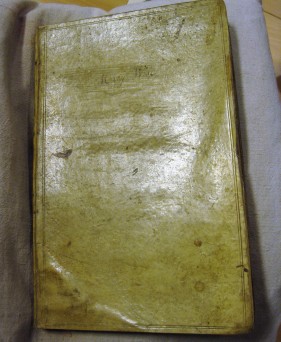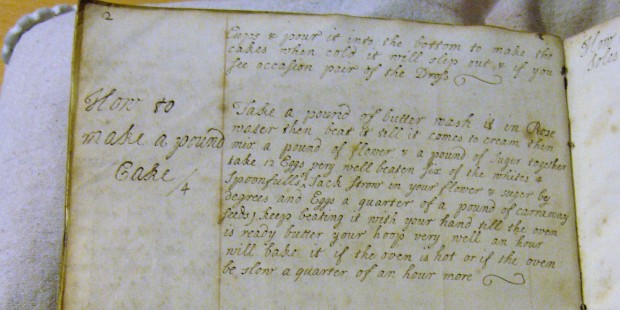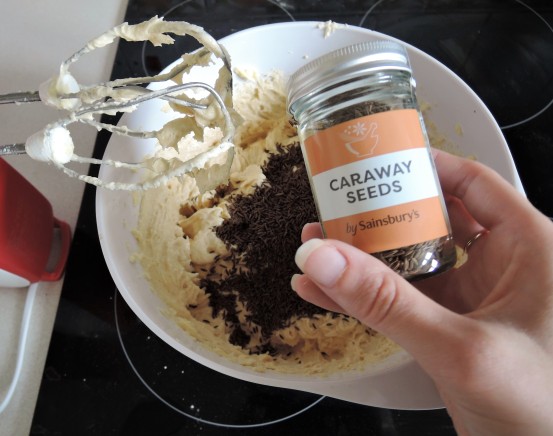https://raspberrythriller.wordpress.com/2017/06/24/reconstructing-18th-century-recipes/
Something entirely new on the blog this week! I’m joining The Recipes Project for a digital conference all about the history of recipes called ‘What is a Recipe?’, which is running this month on various social media platforms. For the first time, I’m uniting my professional life as a historian of the social history of medicine with my personal hobby as a blogger and baker!
If you’re joining from The Recipes Project and #recipesconf, then welcome to my blog. For my regular readers, I hope you’ll find this post interesting as I unite my love of baking with history!
Background:
My research is within the social history of medicine and my expertise is on domestic medicine and manuscript recipe collections from 18thC. England. Since I began researching 18thC. recipes in 2009, I’ve often wondered how challenging it would be to reproduce them. Would I be able to re-create an 18thC. cake and will it be edible (or even delicious)? What does an 18thC. remedy actually taste like, and how will my modern understanding of medicine influence my selection of a remedy and ‘non-hazardous’ ingredients to ensure safe use?
After sifting through several manuscripts and countless recipes, I finally settled on one medicinal and one culinary recipe that I wanted to re-create. You can find out more about this selection process and sourcing ingredients over at The Recipes Project on Tuesday 27th June.
Mary Wise’s Recipe Book

The recipes I reconstructed come from an 18thC. manuscript recipe book owned by Mary Wise, which has a variety of culinary and medical recipes intermixed. There is a table of contents, and it appears that it was recorded in at least two different hands, indicating that either it was a collaborative project, or that the manuscript was passed between (inherited by) different individuals. This collection is housed at the Warwickshire Country Record Office and belonged to the Wise family of Woodcote. There are two manuscripts held within the family estate: one early 18thC. manuscript associated with Henry Wise (Sr.) and the other, constructed later, belonging to Mary Wise.
Henry Wise (1653-1738) was a gardener at Brompton Nursery, now the site of the Royal Albert Hall. His expertise in horticulture and landscaping, including designing gardens at Hampton Court, Chatsworth, and Kensington Gardens, resulted in his appointment as Royal Gardener to Queen Anne and George I. His successful career and resulting wealth allowed Henry to move his family to an estate called The Priory, in Warwickshire. The earlier manuscript was likely created by Henry’s wife Patience and it has many remedies recorded in it for Henry, including correspondence with notable physician, George Cheyne.
Mary Wise [née Mary Tilson] married Henry Wise’s second surviving son (also called Henry Wise) in 1732, and she died in 1760. Mary likely inherited the earlier collection from her mother-in-law, in addition to creating her own manuscript.
Both recipes I trialled are found at the start of the manuscript following the table of contents. The ‘Lipsave’ remedy is the third recipe in the collection, followed by the pound cake recipe on the next page.
To Recap:
This morning, I reconstructed a lip salve recipe and live tweeted my experience [@KAllen622]. This afternoon, I reconstructed the pound cake recipe over on Instagram and you can view my Insta Story (for 24 hrs) for full details [@raspberrythriller62].
‘How to make Lipsave’:


Take 1 Ounce of the best Yellow beeswax cut
it fine & put to it two ounces of the best fresh
butter & about twenty reasons stoned & cut fine
& two golden pipins paired & cut & 3 spoonfuls
of orange flower water put it all into a silver
pot & set it over a clear fire to boyl stirring
it all the while let it boyl full quarter of an
hour or better turn down some large china cups
& pour it into the bottom to make the
cakes when cold it will slip out & if you
see occasion pair of the Drops
it fine & put to it two ounces of the best fresh
butter & about twenty reasons stoned & cut fine
& two golden pipins paired & cut & 3 spoonfuls
of orange flower water put it all into a silver
pot & set it over a clear fire to boyl stirring
it all the while let it boyl full quarter of an
hour or better turn down some large china cups
& pour it into the bottom to make the
cakes when cold it will slip out & if you
see occasion pair of the Drops
Apart from sourcing the correct ingredients (which I will discuss Tuesday), the main challenge I had with this recipe was knowing how small to chop the ingredients. For instance, the recipe does not mention any straining, and after 15 minutes of boiling I still had sizable chunks of apple in my saucepan. I decided to strain only the liquid out into my cups, and discarded the apple and raisins.
The other issue I had is that I don’t own any china cups for storing the lip salve in. Unfortunately, the mixture stuck to the metal cups, so the cakes didn’t ‘slip out’ as described in the recipe. As was acknowledged in the Twitter discussion, this recipe is fairly simple and did not require equipment such as a bain marie (water bath) or a distillation apparatus.
The mixture cooled to a firm consistency owing to the beeswax and butter (and potentially from the pectin found in the apple). It has a greasy feel; however, butter (fats) was a common ingredient in early modern remedies for treating burns and it would have helped to treat dry lips and acted as a barrier and moisturizer. My lips still feel so soft, so I can attest to the efficacy of this remedy! The appeal of this lip salve definitely comes from the scent: the orange blossom water and apples give it a sweet floral aroma. Hopefully I can store it in the fridge for a few days to keep testing it out!
‘How to make a pound Cake’:
It is thought that the pound cake originated in Europe in the early 18th century. This means that Mary Wise could have inherited this recipe from an ancestor, or created it herself!


Take a pound of butter wash it in Rose
water then beat it till it comes to cream then
mix a pound of flower & a pound of Suger together
take 12 Eggs very well beaten Six of the whites 4
Spoonfulls ^of Sack Strew in your flower & suger by
degrees and Eggs a quarter of a pound of carraway
seeds, keep beating it with your hand till the oven
is ready butter your hoop very well an hour
will bake it if the oven is hot or if the oven
be slow a quarter of an hour more
water then beat it till it comes to cream then
mix a pound of flower & a pound of Suger together
take 12 Eggs very well beaten Six of the whites 4
Spoonfulls ^of Sack Strew in your flower & suger by
degrees and Eggs a quarter of a pound of carraway
seeds, keep beating it with your hand till the oven
is ready butter your hoop very well an hour
will bake it if the oven is hot or if the oven
be slow a quarter of an hour more
Conversion for half-size pound cake:
227g. butter
2 tsp. rose water
227g. flour
227g. sugar
3 large eggs and 2 egg whites
2 tbsp. medium dry sherry
56g. caraway seeds
2 tsp. rose water
227g. flour
227g. sugar
3 large eggs and 2 egg whites
2 tbsp. medium dry sherry
56g. caraway seeds
Cream the butter with the rose water until light and fluffy.
[Note: when you churn your own butter it needs to be washed in cold water to remove the buttermilk in order to increase its shelf life. See this post on an American colonial culinary history blog for comparison.]
[Note: when you churn your own butter it needs to be washed in cold water to remove the buttermilk in order to increase its shelf life. See this post on an American colonial culinary history blog for comparison.]
Sift the dry ingredients together.
Whisk the eggs together in a separate bowl
[Note: I used 5 eggs instead of 6 because modern eggs are likely larger than 18thC. eggs].
[Note: I used 5 eggs instead of 6 because modern eggs are likely larger than 18thC. eggs].
Add in the sherry to the eggs
[Note: sack is the early modern term for a fortified white wine originating from Spain; dry sherry is a good substitute].
[Note: sack is the early modern term for a fortified white wine originating from Spain; dry sherry is a good substitute].
Add the dry ingredients gradually to the butter, alternating with the egg mixture.
Mix in the caraway seeds.
[Note: Dense seeded cakes were very popular in the 16th/17th C. which means that this recipe could have been passed down to Mary who recorded it in the 18th century.]
[Note: Dense seeded cakes were very popular in the 16th/17th C. which means that this recipe could have been passed down to Mary who recorded it in the 18th century.]

Pour into a buttered bundt tin
[Note: A hoop (more information) is an early modern term for a cake tin and they often didn’t have bottoms on them.]
[Note: A hoop (more information) is an early modern term for a cake tin and they often didn’t have bottoms on them.]

Bake at 180C for 45 minutes. Let cool before inverting.
[Note: Notice there is no temperature in the recipe – this was common in early modern recipes owing to baking being done in a fire-based oven. As I halved the recipe, my cake only took 45 minutes, but a full pound cake would likely take 1 hour in a hot oven as Mary’s recipe suggests.]
[Note: Notice there is no temperature in the recipe – this was common in early modern recipes owing to baking being done in a fire-based oven. As I halved the recipe, my cake only took 45 minutes, but a full pound cake would likely take 1 hour in a hot oven as Mary’s recipe suggests.]

Delicious! Tastes like a regular pound cake but with the essence and crunch of a rye bread 



